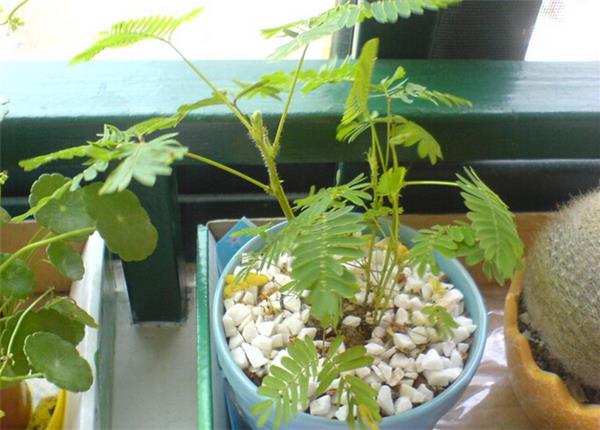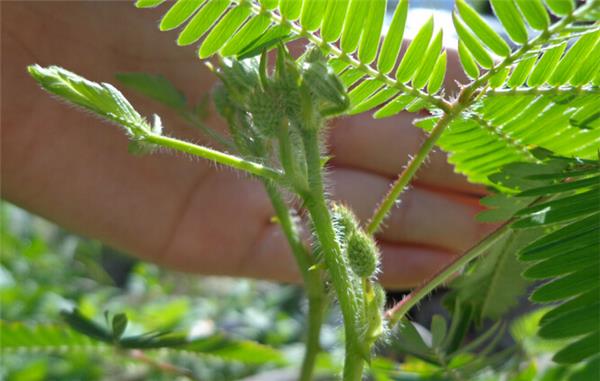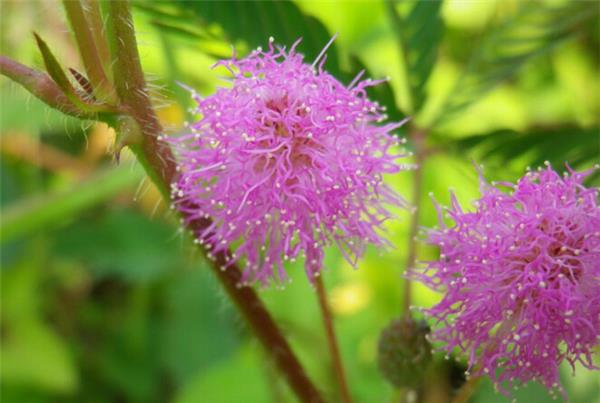How to raise mimosa, how to simply raise a healthy mimosa
The leaves of mimosa will respond to heat and light, and will close immediately when touched by external forces, so it is named mimosa. The flower of mimosa is pink, shaped like a furry ball, and is very likable. Mimosa not only has a better ornamental effect, but also easier to survive, suitable to do balcony, indoor potted flowers. So how to raise mimosa?

How to raise mimosa
☆ 1, soil. General soil can be cultivated, but the fertile, loose sandy loam is better, which requires the soil to be deep, fertile and moist.
☆ 2, fertilization. Do not need much fertilizer during the growing period, apply dilute liquid fertilizer for 2 or 3 times, fertilizer should not be too much, grow healthily with leaf green, do not grow in vain, because mimosa is mainly interesting foliage flowers, small is better.
☆ 3. Watering. Mimosa likes to be moist and needs to be watered frequently, once a day during the summer growing season. Shy prairie is a tropical plant, like a humid environment, so always keep the basin soil moist, watering the basin soil in summer, about once a day, do not let the soil dry, you can often spray water to the plants, and reduce the amount of water in winter to prevent freezing damage.
☆ 4, light. Ensure plenty of sunshine, mimosa likes sunlight, it is best to put it on a sunny balcony or window, full exposure to sunlight is good for mimosa growth, if too little sunlight, it may hinder its growth.

☆ 5, prevention of diseases and insect pests, mimosa is generally very few diseases and insect pests, the most common pest is slug, if found, you can sprinkle some lime powder for control. If the plant does not grow well, check to see if the light source is insufficient or the water is not enough.
The common name of mimosa is "mimosa" and "inductive grass". It is a perennial herb of the genus Mimosa of Leguminosae. Plant height 30-60 cm; stem trailing, much branched, scattered barbed hairs, sharp thorns all over the body; petiole 1.5-4 cm long; stipules lanceolate, spiny; leaves pinnate, 2-colored 4 pieces palmately arranged, leaflet moment rounded, closed and pendulous; flowers many, capitate, generally pink, flowering from July to October; pods flat, margin spiny, 3-4 pods, 2 seeds per node, falling after maturity. So, do you know why mimosa is shy?
Why is the mimosa shy?

In fact, the phenomenon that mimosa folds up its petiole and lowers its head is not because of shyness, but a response of plants to stimulation and vibration. This response, known as perceptual movement in biology, is the result of changes in cell tension when mimosa is stimulated by external stimuli.


The hometown of mimosa is in Brazil in tropical South America, where there are often strong winds and heavy rain. Whenever the first drop of rain hits the leaves, it immediately closes the leaves and the petiole droops to reduce the damage caused by the storm. This is a way for it to adapt to the changes of external environmental conditions. In addition, this reaction of mimosa can also be seen as a way of self-defense. When an animal touches it, it closes its leaves, and animals dare not eat it any more.

The reason why mimosa is shy is closely related to its native environment. The shy prairie comes from tropical South America, where the climate is bad and there are often high winds and torrential rains. In order to protect itself, when the first drop of Rain Water falls on the mimosa leaf, it will close the leaf promptly and effectively and hang its petiole to avoid the damage of the storm, which is the self-adjustment of the biological world.
At the base of the petiole and at the base of the leaflet of the compound leaf, there is a relatively inflated part called the leaf pillow. When the vibration reaches the leaf pillow, the cell fluid from the parenchyma cells in the upper half of the leaf pillow is discharged into the intercellular space, which reduces the turgor pressure of the cells in the upper part of the leaf pillow, while the parenchyma cell space in the lower part still maintains the original turgor pressure. as a result, the leaflets stand upright, the two leaflets close, and even the whole leaf hangs down.
Mimosa is a perennial herb or subshrub of Leguminosae, which is named mimosa because its leaves respond to heat and light and close immediately when touched by external forces. Native to tropical South America, it likes to be warm and humid, and is not strict with the soil. The flower is pink, shaped like a fluffy ball, delightful. Pods bear fruit after flowering, and the fruit is flat and round. What is the use of such a lovely mimosa?
The role of mimosa:
The function of ☆ mimosa: 1. Ornamental ☆
Mimosa plant shape scattered, feather leaves slender and beautiful, its leaves are closed at a touch; mimosa flowers are many and beautiful, charming, giving people the impression of weak and elegant. It can be planted in the corner of the courtyard or potted in the window. When giving flowers, gently cover the potted plants with pink tulle and tie them with pink ribbons and knots. It would be more interesting if you could adorn it with pink mohair balls.
The function of ☆ mimosa: 2. Forecast weather ☆
Mimosa is a wonderful plant that can predict changes in the weather. If you touch it with your hand, its leaves close quickly and open slowly, indicating that the weather will clear up; if you touch mimosa, its leaves contract slowly, droop slowly, or even reopen a little bit, this means that the weather will change from sunny to overcast or it is going to rain.
The function of ☆ mimosa: 3. Predicting earthquake ☆
According to Turkish seismologist Erjiang, a few hours before a strong earthquake, the leaves of mimosa, which are sensitive to the outside world, suddenly shrink and then wither. In earthquake-prone Japan, scientists have found that under normal circumstances, mimosa leaves open during the day and close at night. If the leaves of mimosa close during the day and open at night, it is a sign of an earthquake.
The function of ☆ mimosa: 4. Medicinal ☆
It has the effects of clearing heat and diuresis, resolving phlegm and relieving cough, calming nerves and relieving pain, detoxification, removing blood stasis, hemostasis, convergence and so on. For colds, children with high fever, acute conjunctivitis, bronchitis, gastritis, enteritis, urinary calculi, malaria, neurasthenia; external treatment of swelling and pain, sores, hemoptysis, herpes zoster.
The above is the editor for you how to raise mimosa and the role of mimosa. Mimosa has ornamental and medicinal functions, and it also has the unique role of weather prediction and earthquake prediction. Those who like mimosa might as well raise several pots and decorate them at home. The editor hopes that this article can help you better cultivate mimosa.
It will quickly close the leaves in time and effectively, hang the petiole, and avoid the damage of the storm, which is the self-regulation of the biological world.
At the base of the petiole and at the base of the leaflet of the compound leaf, there is a relatively inflated part called the leaf pillow. When the vibration reaches the leaf pillow, the cell fluid from the parenchyma cells in the upper half of the leaf pillow is discharged into the intercellular space, which reduces the turgor pressure of the cells in the upper part of the leaf pillow, while the parenchyma cell space in the lower part still maintains the original turgor pressure. as a result, the leaflets stand upright, the two leaflets close, and even the whole leaf hangs down.
Mimosa is a perennial herb or subshrub of Leguminosae, which is named mimosa because its leaves respond to heat and light and close immediately when touched by external forces. Native to tropical South America, it likes to be warm and humid, and is not strict with the soil. The flower is pink, shaped like a fluffy ball, delightful. Pods bear fruit after flowering, and the fruit is flat and round. What is the use of such a lovely mimosa?
The role of mimosa:
The function of ☆ mimosa: 1. Ornamental ☆
Mimosa plant shape scattered, feather leaves slender and beautiful, its leaves are closed at a touch; mimosa flowers are many and beautiful, charming, giving people the impression of weak and elegant. It can be planted in the corner of the courtyard or potted in the window. When giving flowers, gently cover the potted plants with pink tulle and tie them with pink ribbons and knots. It would be more interesting if you could adorn it with pink mohair balls.
The function of ☆ mimosa: 2. Forecast weather ☆
Mimosa is a wonderful plant that can predict changes in the weather. If you touch it with your hand, its leaves close quickly and open slowly, indicating that the weather will clear up; if you touch mimosa, its leaves contract slowly, droop slowly, or even reopen a little bit, this means that the weather will change from sunny to overcast or it is going to rain.
The function of ☆ mimosa: 3. Predicting earthquake ☆
According to Turkish seismologist Erjiang, a few hours before a strong earthquake, the leaves of mimosa, which are sensitive to the outside world, suddenly shrink and then wither. In earthquake-prone Japan, scientists have found that under normal circumstances, mimosa leaves open during the day and close at night. If the leaves of mimosa close during the day and open at night, it is a sign of an earthquake.
The function of ☆ mimosa: 4. Medicinal ☆
It has the effects of clearing heat and diuresis, resolving phlegm and relieving cough, calming nerves and relieving pain, detoxification, removing blood stasis, hemostasis, convergence and so on. For colds, children with high fever, acute conjunctivitis, bronchitis, gastritis, enteritis, urinary calculi, malaria, neurasthenia; external treatment of swelling and pain, sores, hemoptysis, herpes zoster.
The above is the editor for you how to raise mimosa and the role of mimosa. Mimosa has ornamental and medicinal functions, and it also has the unique role of weather prediction and earthquake prediction. Those who like mimosa might as well raise several pots and decorate them at home. The editor hopes that this article can help you better cultivate mimosa.
Related
- Wuhan Hospital Iron Tree Blooming Result Was Instantly Frightened by the Gardener Master
- Which variety of camellia is the most fragrant and best? Which one do you like best?
- What is the small blue coat, the breeding methods and matters needing attention of the succulent plant
- Dormancy time and maintenance management of succulent plants during dormancy
- Minas succulent how to raise, Minas succulent plant pictures
- What are the varieties of winter succulent plants
- How to raise succulent plants in twelve rolls? let's take a look at some experience of breeding twelve rolls.
- Attention should be paid to water control for succulent plants during dormant period (winter and summer)
- Watering experience of twelve rolls of succulent plants
- Techniques for fertilizing succulent plants. An article will let you know how to fertilize succulent plants.



